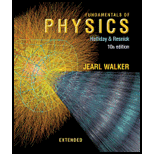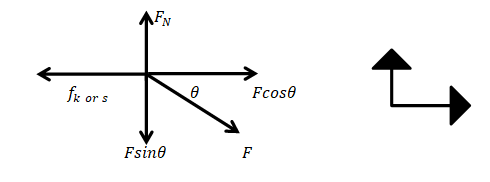
Concept explainers
In Fig. 6-12, if the box is stationary and the angle θ between the horizontal and force

Figure 6-12 Question 1.
To find:
Whether the following quantities increase, decrease, or remain the same when an applied force is directed downward at an angle
(a)
(b)
(c)
(d)
(e) And, whether the magnitude of the frictional force on the box increases, decreases, or remains the same if the angle θ is increased.
Answer to Problem 1Q
Solutions:
(a) The value of horizontal force
(b)
(c) The value of the normal force
(d)
(e) The friction force increases when the box slides and the angle between the surface and box also increases.
Explanation of Solution
Concepts
If the block slides, then kinetic frictional force is given by
Explanations:
Given Data:
In the problem (a) to (b): the box is stationary and the angle
Note: It is clear from Fig. 6-12, the angle
Formula used:
The free-body depiction for the inclined slope is provided below.
From Fig. (6-19) of the textbook and the free body diagram, we can draw:

No acceleration in the first case (from (a) to (d)) as the box is in the stationary position. Hence, acceleration is zero.
Applying Newton’s 2nd law on the y-axis:
If the block slides, the kinetic frictional force:
If it does not slide, then the magnitude of maximum static friction:
Calculations: To find the magnitude of the different forces and their nature (increasing, decreasing, or no-change) when the angle (
(a) The horizontal component of the force is
(b) If a body does not move, the static frictional force and the component parallel to the surface are equal in magnitude, and is directed opposite that component. If the component decreases,
(c) The normal component of the force is given in Eq. (1).
The normal component of the force is
(d) From Eq. (3), the magnitude of the maximum static friction will also increase as
(e) In the sliding scenario, kinetic friction force can be explained by Eq. (2). This results in an increase in the kinetic frictional force. Thus, the friction force increases when the box slides and the angle between the surface and box increases.
Conclusion
If the value of the normal force
Want to see more full solutions like this?
Chapter 6 Solutions
Fundamentals of Physics Extended
Additional Science Textbook Solutions
Chemistry: A Molecular Approach (4th Edition)
Chemistry: Structure and Properties (2nd Edition)
Cosmic Perspective Fundamentals
Campbell Biology (11th Edition)
Physics for Scientists and Engineers: A Strategic Approach, Vol. 1 (Chs 1-21) (4th Edition)
Human Biology: Concepts and Current Issues (8th Edition)
- Don't use ai to answer I will report you answerarrow_forwardwhy did the expert subtract the force exerted by the hand and the elbow by the force due to the weight of the hand and forearm and force exerted by the tricep. Does the order matter and how do you determine what to put first. Question 4 AP, CHAPTER 13 FROM BASIC BIOMECHANICS 8TH EDITIONarrow_forwardThe drawing illustrates the dispersion of light by a prism. The prism is made from a certain type of glass, and has a cross section shaped like an equilateral triangle. The indices of refraction for the red and violet light in this type of glass are 1.649 and 1.694, respectively. The angle of incidence for both the red and violet light is 60.0°. Find the angles of refraction at which the (a) red and (b) violet rays emerge into the air from the prism. Glass prism Incident light Normal (a) Normal Incident light Red (660 nm) (b) Violet (410 nm)arrow_forward
- Don't use ai to answer I will report you answerarrow_forwardA glass block (n = 1.56) is immersed in a liquid. A ray of light within the glass hits a glass- liquid surface at a 70.0° angle of incidence. Some of the light enters the liquid. What is the smallest possible refractive index for the liquid?arrow_forwardThe drawing shows a crystalline slab (refractive index 1.995) with a rectangular cross section. A ray of light strikes the slab at an incident angle of 01 = 35.0°, enters the slab, and travels to point P. This slab is surrounded by a fluid with a refractive index n. What is the maximum value of n such that total internal reflection occurs at point P? Ме Buarrow_forward
- What is the amount of M112 needed to breach a 5-foot thick dense concrete wall utilizing an internal charge placed in the center of the target?arrow_forwardA small postage stamp is placed in front of a concave mirror (radius = 1.1 m), such that the image distance equals the object distance. (a) What is the object distance? (b) What is the magnification of the mirror (with the proper sign)?arrow_forwardCalculate the anti-clockwise torque and the clockwise torque of the system with the ruler and the washers. Record these values in Data Table 5. Ruler = 11.56 g, small washer = 1.85 g, large washer = 24.30 g. Calculate the % Difference in the Torques and record the values in Data Table 5. Is ΣAnticlockwise torque and Anticlockwise torque the same thing, are they solved in the same way?arrow_forward
- A window washer stands on a uniform plank of mass M = 142 kg and length l = 2.80 m supported by 2 ropes attached at the ends of the plank. The window washer has a mass m = 68.0 kg. What is the tension in each of the ropes, T1 and T2, if the window washer's displacement from the center of mass of the plank is x = 0.930 m as shown in Figure 1: Window Washer Problem?arrow_forwardA man holds a double-sided spherical mirror so that he is looking directly into its convex surface, 33 cm from his face. The magnification of the image of his face is +0.17. What will be the image distance when he reverses the mirror (looking into its concave surface), maintaining the same distance between the mirror and his face? Be sure to include the algebraic sign (+ or -) with your answer.arrow_forwardHow do you draw a diagram of the ruler and mass system in equilibrium identifying the anti-clockwise torque and clockwise torque? How do I calculate the anti-clockwise torque and the clockwise torque of the system with the ruler and the washers, does it come from the data in table 4? Please help, thank you!arrow_forward
 Classical Dynamics of Particles and SystemsPhysicsISBN:9780534408961Author:Stephen T. Thornton, Jerry B. MarionPublisher:Cengage Learning
Classical Dynamics of Particles and SystemsPhysicsISBN:9780534408961Author:Stephen T. Thornton, Jerry B. MarionPublisher:Cengage Learning Principles of Physics: A Calculus-Based TextPhysicsISBN:9781133104261Author:Raymond A. Serway, John W. JewettPublisher:Cengage Learning
Principles of Physics: A Calculus-Based TextPhysicsISBN:9781133104261Author:Raymond A. Serway, John W. JewettPublisher:Cengage Learning University Physics Volume 1PhysicsISBN:9781938168277Author:William Moebs, Samuel J. Ling, Jeff SannyPublisher:OpenStax - Rice University
University Physics Volume 1PhysicsISBN:9781938168277Author:William Moebs, Samuel J. Ling, Jeff SannyPublisher:OpenStax - Rice University College PhysicsPhysicsISBN:9781938168000Author:Paul Peter Urone, Roger HinrichsPublisher:OpenStax College
College PhysicsPhysicsISBN:9781938168000Author:Paul Peter Urone, Roger HinrichsPublisher:OpenStax College Physics for Scientists and Engineers: Foundations...PhysicsISBN:9781133939146Author:Katz, Debora M.Publisher:Cengage Learning
Physics for Scientists and Engineers: Foundations...PhysicsISBN:9781133939146Author:Katz, Debora M.Publisher:Cengage Learning Physics for Scientists and Engineers with Modern ...PhysicsISBN:9781337553292Author:Raymond A. Serway, John W. JewettPublisher:Cengage Learning
Physics for Scientists and Engineers with Modern ...PhysicsISBN:9781337553292Author:Raymond A. Serway, John W. JewettPublisher:Cengage Learning





